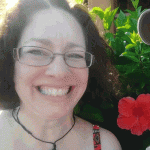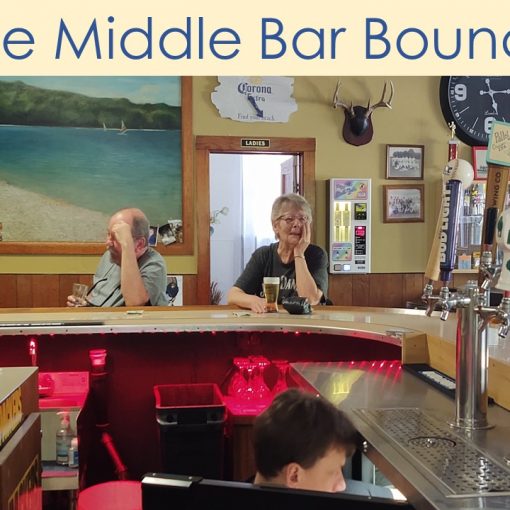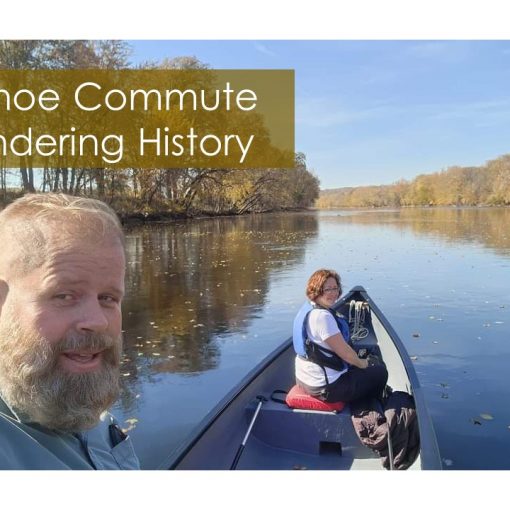Tulip Time! I had received a text from my husband, Chuck, “4:15 Dinner at Boatwerks?” Boatwerks is a restaurant in Holland, Michigan. He had been volunteering on the 1810 replica ship, Friends Good Will, in Holland for Tulip Time. “YES!” I replied. The Michigan Maritime Museum had sailed their wooden merchant ship, which has Civil War history, from South Haven to Holland for the eight day festival so they could give tours.
I was looking forward to seeing the floral displays, the people shining in their heritage and dinner with my handsome guy! I hadn’t realized how entirely special this caper would be for me! I had learned so much about windmills and the culture of The Netherlands. The “Dutch Touch” will forever be in my heart! Join me for Tulip Time!
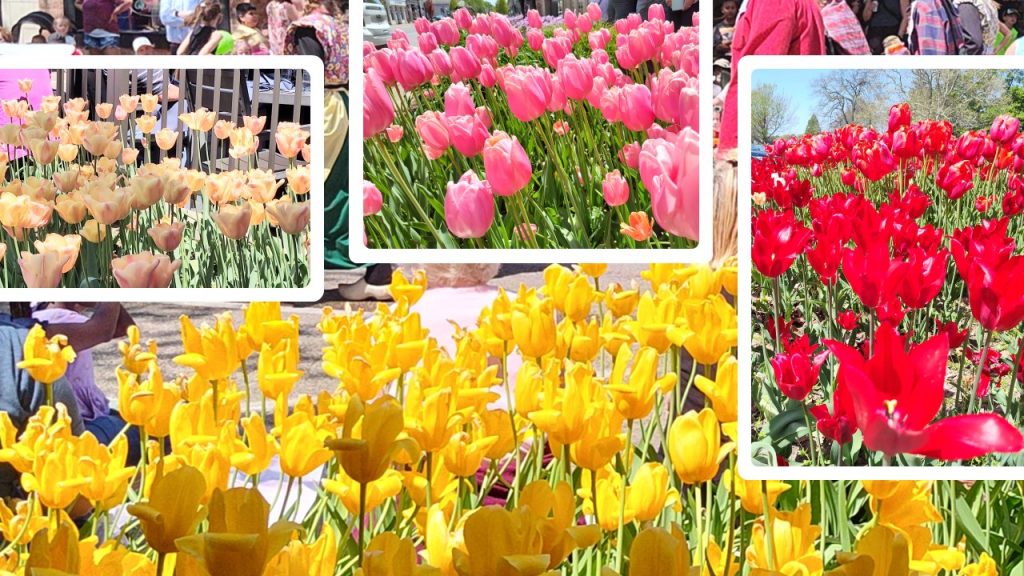
Knowing it would be a crowded festival, I left at 1:00 for the hour journey to the lakeshore. Sure enough, when I arrived at 2:00 pm many streets had been blocked off, so I parked nearly a mile from restaurant and began my stroll. In the distance cymbals crashed and clanged. Drums rattled and boomed. Excited voices carried as I made my way around the corner.
Preparing For The Kinder Parade
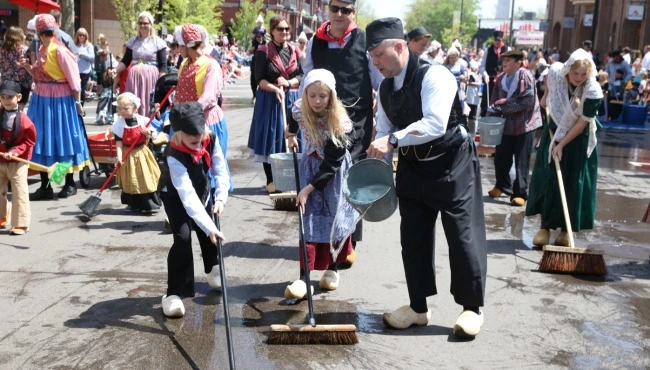
Photo Credit: WOOD TV
On Thursday, May 11th at 1:30 pm community members had brought their own buckets and long handled brushes to scrub the streets in preparation for the kinder parade. City officials then strolled down the street for the ceremonial ‘white glove inspection’ to approve the conditions for the parade. This tradition is one of many customs referred to as “The Dutch Touch.” Hard work, kindness and pride in accomplishing tasks abound in the Dutch culture.
Meeting Kinder Parade Participants
As I sauntered toward downtown Holland I witnessed the children (kinder) queued up along four avenues which intersected in the middle. (like a plus sign) The troops stretched at least one full block each way. The tulips definitely felt the buzz of excitement dancing in the air.
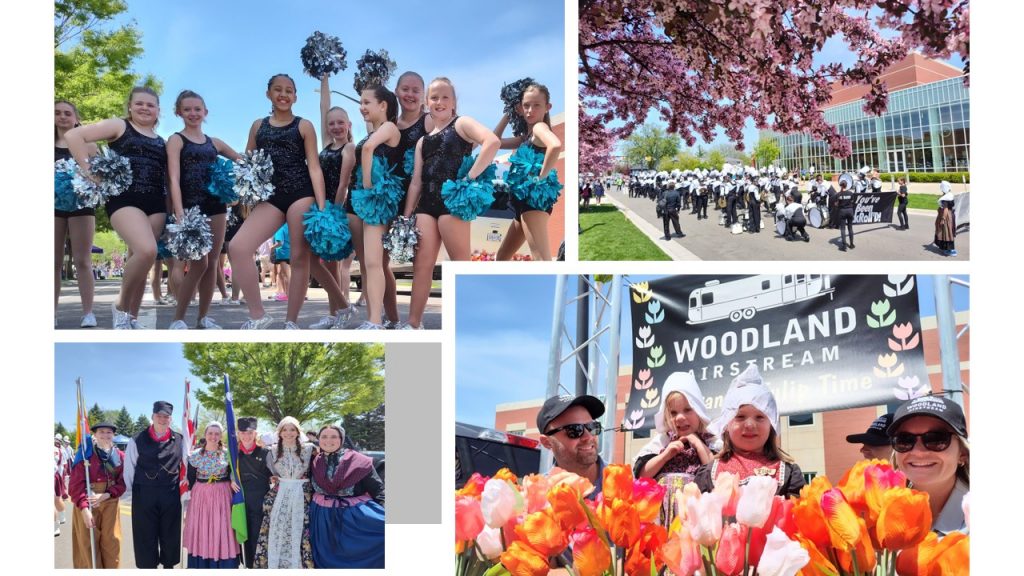
The answers pummeled enthusiastically from smiling faces, “Six!” “Eight!” “Seven!” “Five!” “Seven!” “Six!”
This close knit Dutch community reveled in their culture and customs! I believe we all crave connections and this city has known how to bring their people together by demonstrating pride in their heritage!
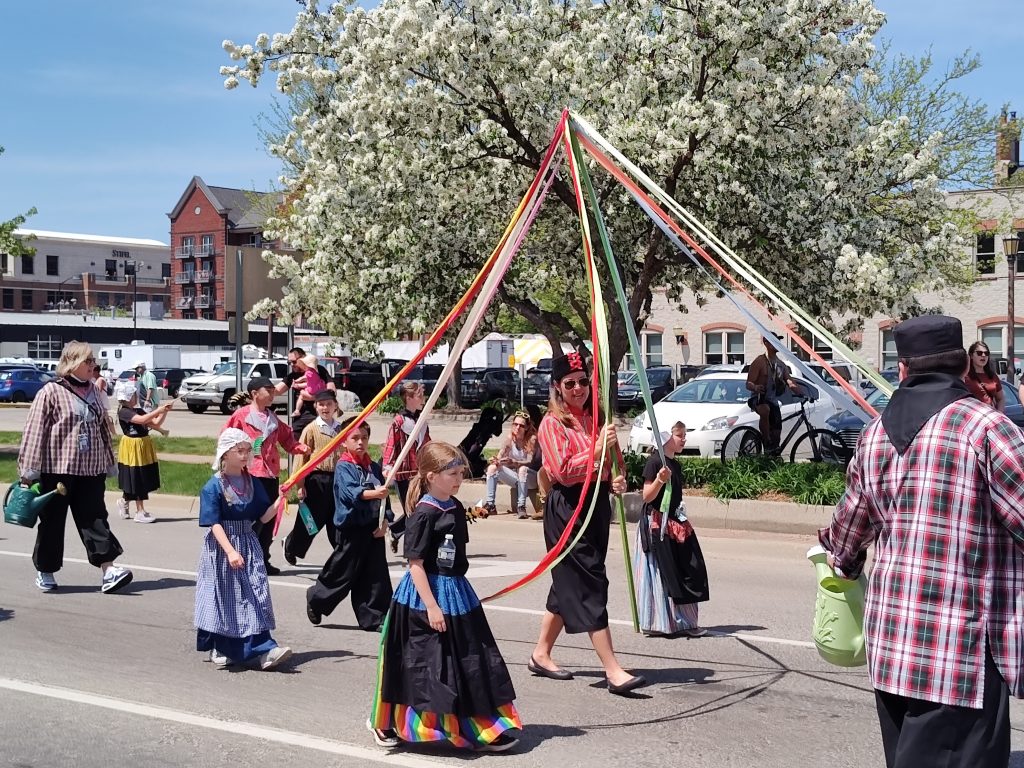
Several European cultures celebrate the beginning of summer by dancing around the Maypole
while weaving the ribbons down the pole as they move rhythmically.
Our Dinner Date
I enjoyed a glass of wine at Boatwerks while I waited for Chuck. Sitting at the bar I met Karen and her band of sisters who regularly travel together. They hail from the east side of lower Michigan. They have come to Tulip Time several times as well as a long list of international travel destinations. Then, I chatted with a kind young woman. Lucy, who works for the State of Michigan. Lucy had heard about Tulip Time and had wanted to experience it herself. It is estimated that well over 500,000 people tour the area to see the brightly colored blooms.
“I haven’t been here since I was a kid.” I admitted to my husband when he joined me. I bubbled about the kinder parade and the flower beds. “Would you like to walk around after dinner?” Chuck’s face and tops of his feet had been reddened from his day in the sun, but he’s always willing to cater to my wishes. “Yes. If you’re up for it.” Chuck nodded as he slurped his iced tea.
The Windmill
After our meal we headed to Windmill Island Garden which holds the last working windmill known as “de Zwaan,” which means “The Swan” in Dutch. Named for the graceful bird, this five story structure is still producing 10,000-12,000 pounds of flour annually.
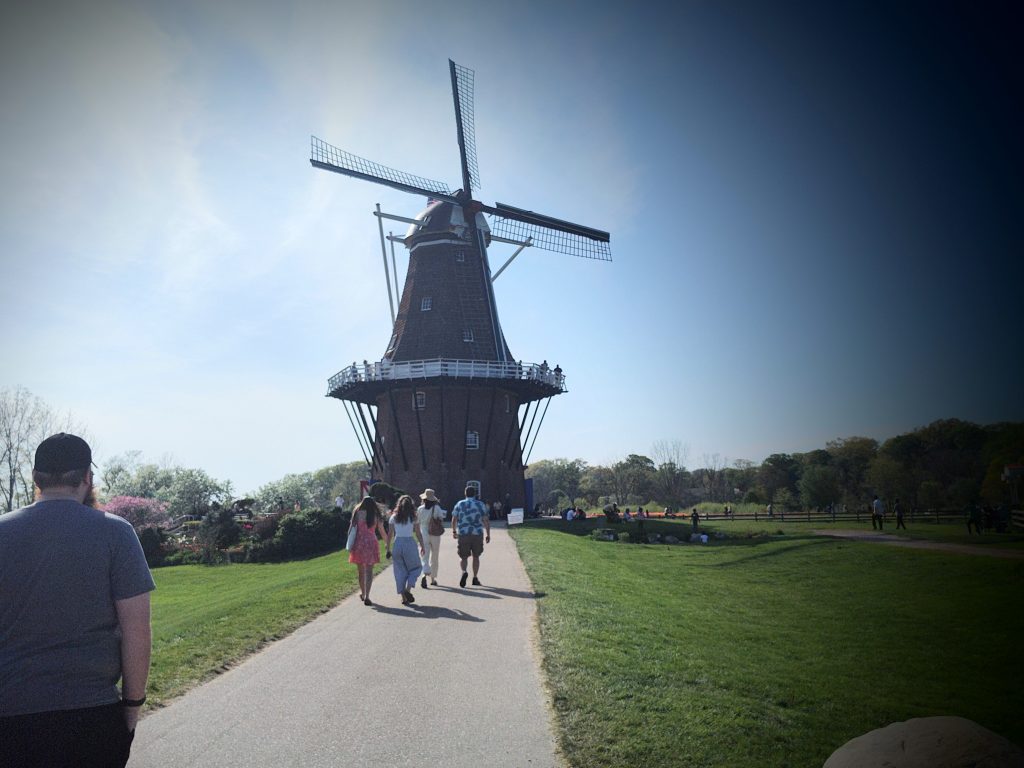
Milling Grain
Farmers could drive their horse drawn buggy through the double doors on the first floor. As the miller worked on the fifth floor, notes and payments could be sent through the “elevator” by a wooden shoe on a string. Bags of wheat and flour would be transferred through this vertical space by pullies.
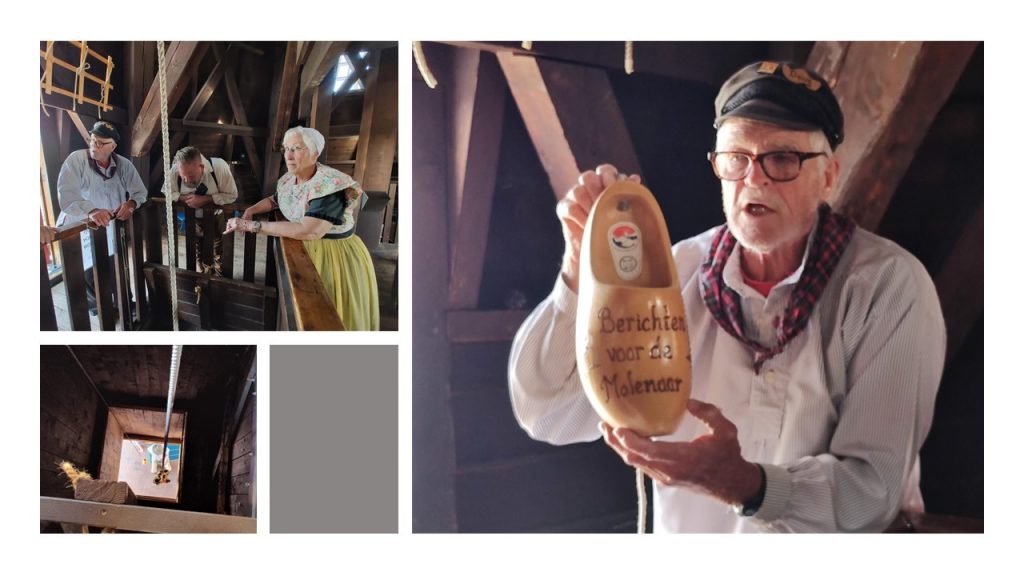
The elevator space is seen on the left.
Packaging
After the grain is processed, flour would be packaged on the third floor. I was amazed to learn that this mill could still operate and has been producing 10,000-12,000 pounds of flour each year. Here’s a cool connection . . . King Milling, in our hometown of Lowell, sends the grain which is then ground into flour.
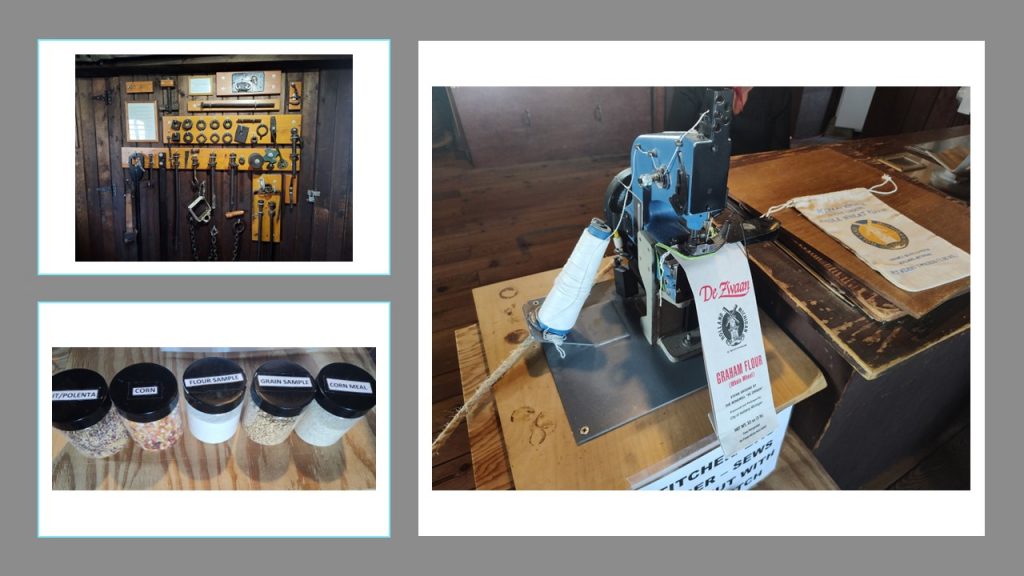
(Bottom Left) Samples of grain and flour were provided for study and analysis.
(Right) Workers would guide the sacks on the sewing machine to stitch the top closed.
Recently, two new millers were being trained by Hanz, who had traveled from the Netherlands. “I loved his accent.” The city employee/retired teacher informed us on our tour. “Hanz and his wife have already headed back.” The previous miller had been laid off during Covid and had found another job. So new millers were now needed. This ancient art needed to be taught by someone with experience, so Hanz was brought over for the lessons.
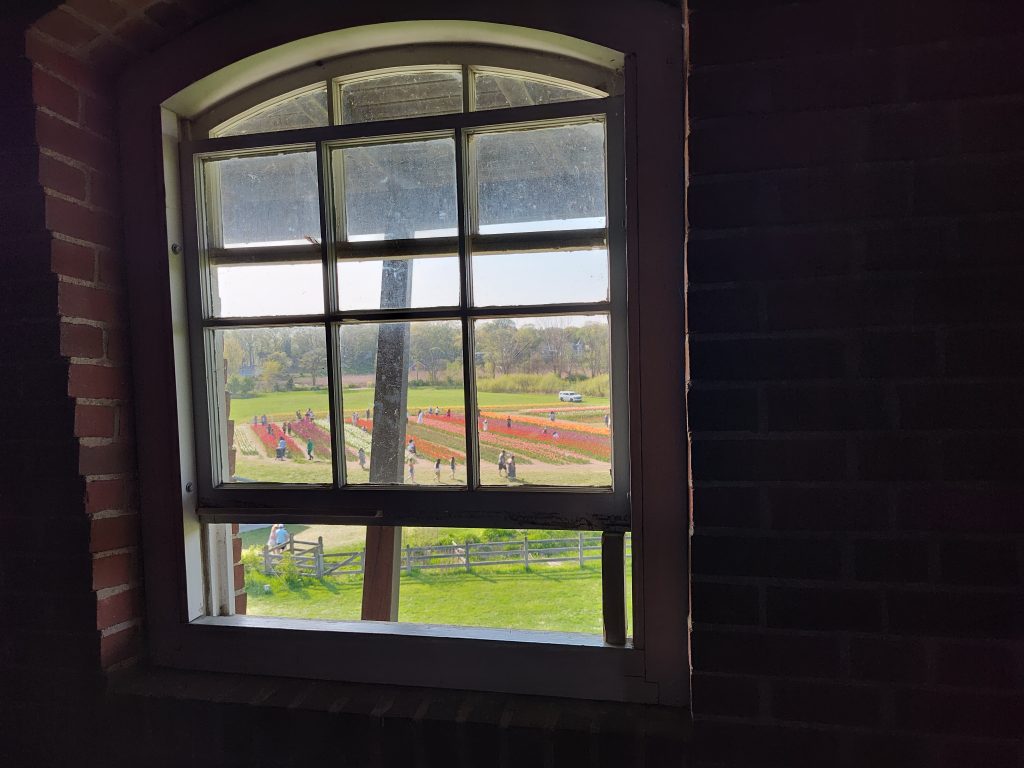
The Secrets of Windmills

In the 1800’s nine thousand windmills had been spread over the 12 providences of The Netherlands. These structures had been the center of their communities and had been used to communicate. Joyous occasions such as weddings and births would have the bottom wing set just left of center.
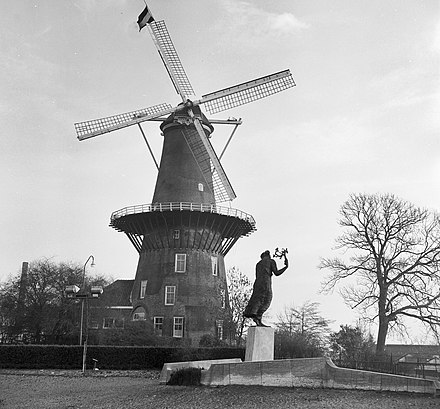
Photo Credit: Wikiwand
The “rouw” position of mourning would be used in the event of a family member’s death. This “rouw” setting had even been used when a royal family member had passed away.
When the blades were left in an “X” formation it meant that the miller was taking a long rest. If the miller was in need of a short break the wings would be set in a “+” position. If the bottom blade has stopped slightly right of the windmill’s silhouette, it means, “So sorry, the grinding stone is in need of sharpening. There is no service today.”
During World War II windmills had been used by both sides as look out towers. When The Netherlands had been captured by Germany, Canadians hid radios on the top floors to communicate with the Allied Forces.
When Germans occupied the region during WWII, the canvases on the wings had been used to inform the community of impending raids. Some windmills had secretly housed people, too.
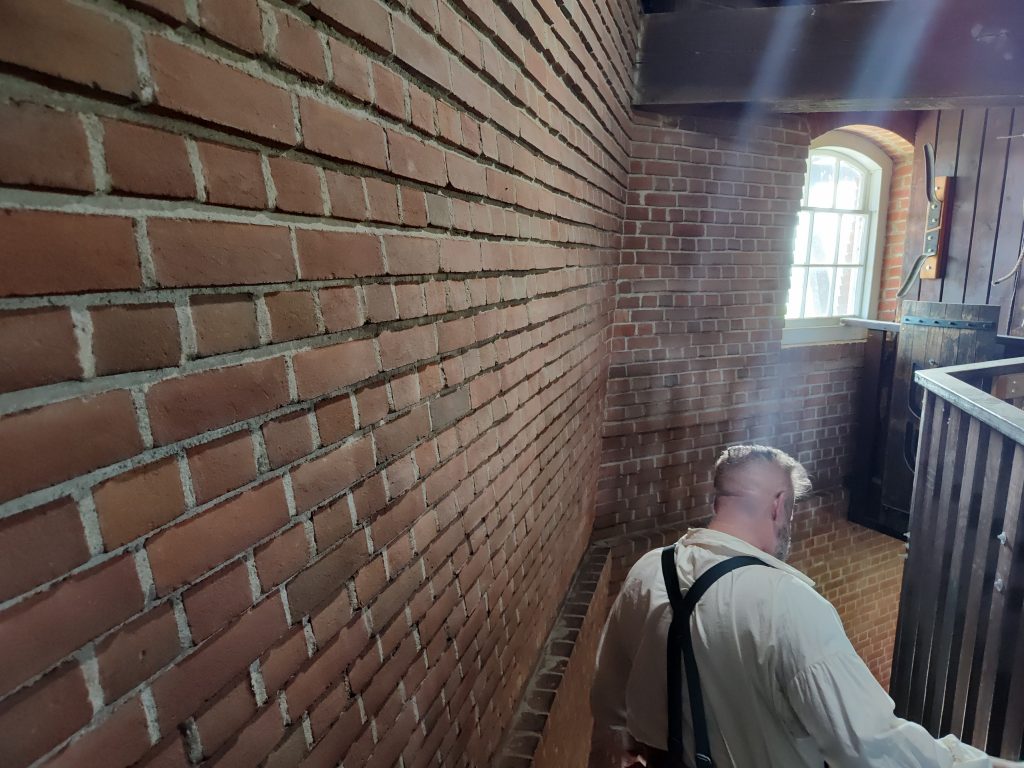
As we came down the stairs the retired teacher informed us, “There will be klompen dancing at 7:00 tonight. It will be along 8th street, downtown, where the parade was today.” Chuck and I shared a look and a nod as we checked the time. “Oh, good.” I commented, “We have time to visit the gift shop!” I think Chuck rolled his eyes as I headed toward the small village shopping area with the hand painted merry-go-round. Sadly, I had walked right by the old barrel organ. I should have stopped there for a look-see, but I had trinkets on my mind.
Klompen Dancing
As we headed back downtown many people dressed in traditional clothing clomped importantly in wooden shoes toward 8th Avenue. Joy bubbled from the people who were about to perform.
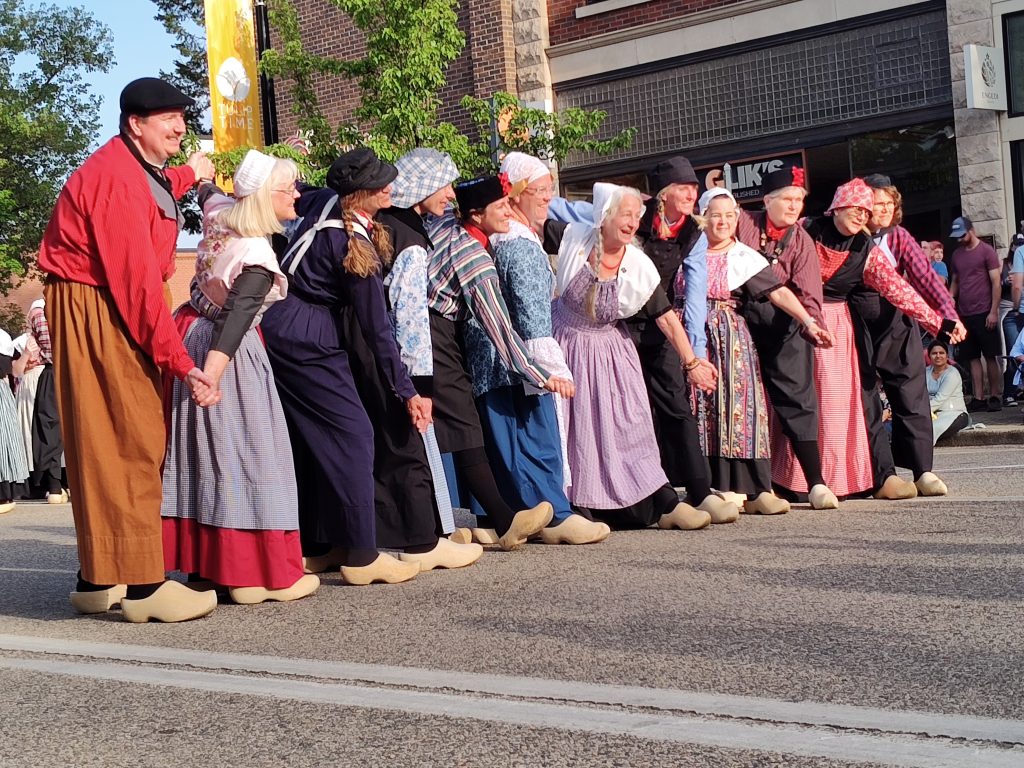
as they greeted one another in the street.
It appeared that they were organized in preset groups of twelve.
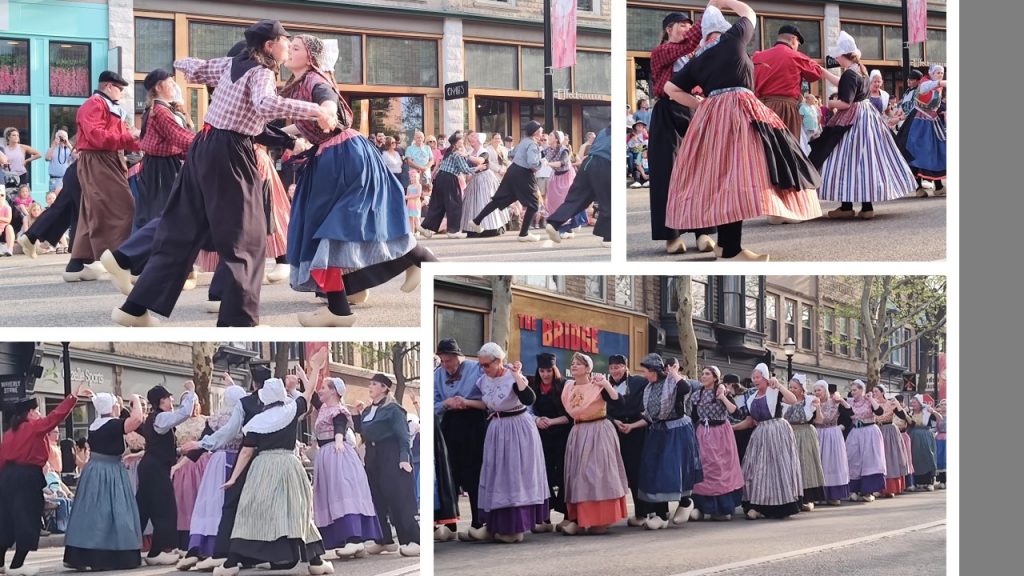
Young and old have happily embraced their Dutch traditions with pride!
The dancers’ energy, punctuated by the clomp of their wooden shoes, had been electrifying. I had goosebumps while they danced through various formations to the beat of organ music. The performance was impressive and heartfelt by the participants and audience alike.
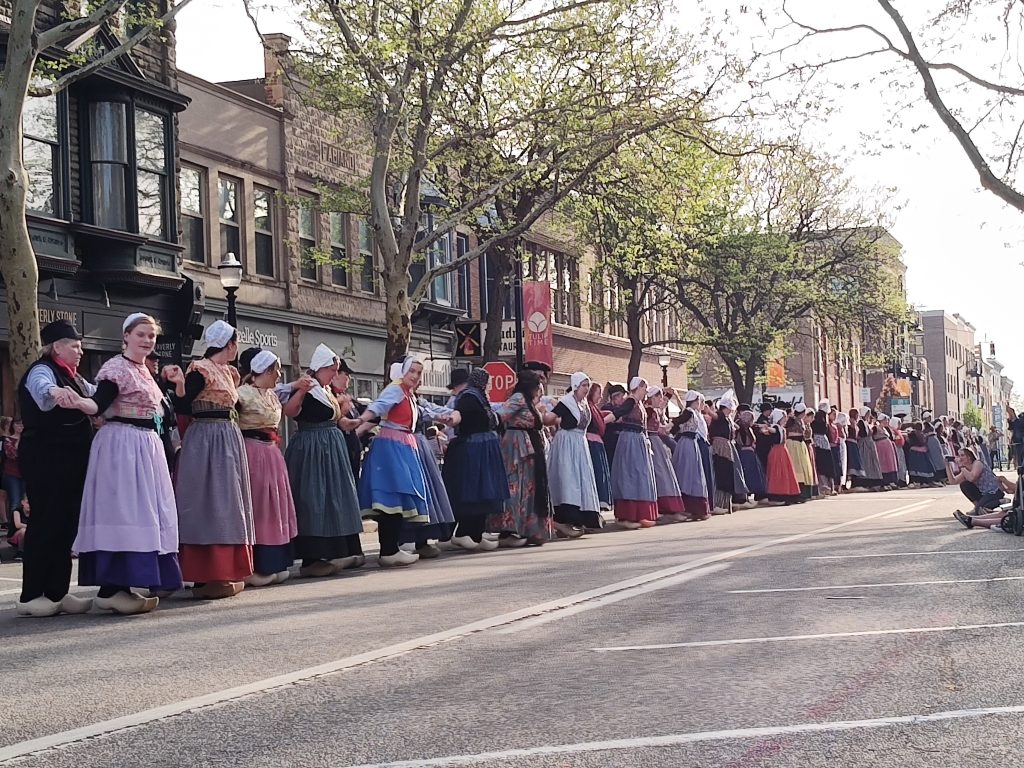
Ether Perry, the gym teacher, who had originally taught these folk dances in 1933,
had created a stunning legecy.
Traditional Outfits
These traditional outfits had been sewn using the Tulip Time specified patterns representing eight of the twelve Netherland providences. These 1850-1950 costumes are inspected by officials to ensure the clothing meets the expectations before one is permitted to dance. The costs for an outfit range from $180.00-$300.00. Fundraising and donations are collected year-round to assist individuals in preparing for the eight day celebration.
I really appreciate how the whole Holland community embraces these Dutch traditions! How did it all start? I had to learn more!
Tulip Time History
Lida Rogers, a Holland High School biology teacher, had been part of the Women’s Literary Club in 1927. Rogers had given a speech entitled, “Civil Beauty,” where she had encouraged Holland officials to name the tulip as the city’s flower. Many residents had firm ties to The Netherlands where tulips had once been a form of currency, a prized commodity.
In 1928, Mayor Ernest C. Brooks had appropriated funds and placed an order for 100,000 tulip bulbs from the Netherlands. These could be purchased from the city at $0.01 each and planted in the fall. The city had planned to celebrate “Tulip Day” the following spring.
So many visitors had viewed the candy colored blooms in the spring of 1929 that it had been decided to create an annual event. Mrs. Ethel Telling was appointed the first “Tulip Time” director. Mrs. Telling had set the high standards by strongly emphasizing the customs and clothing of The Netherlands.
During World War II most events had been cancelled except a flower show and musical concerts. A smaller four day festival resumed in 1946.
Coinciding with Holland’s centennial celebration in 1947, Amsterdam had sent a barrel organ as a gift to the city of Holland. Since then it has been played each year at Tulip Time. After receiving extensive restoration in the 1990’s the organ now welcomes visitors on Windmill Island. (I should have stopped to see it when I had been there.)
That same year, 1947, Governor Kim Sigler had been the first Michigan governor to join in with the custom of cleaning the street. Since then, each governor has participated in scrubbing the road.
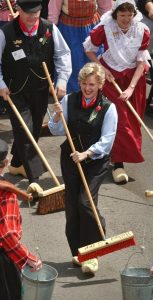
Photo Credit: WOODTV
1976 had been another exhilarating year for Holland. President Gerald R. Ford, his wife, Betty, and daughter, Susan, had attended Tulip Time. In addition, the city of Holland had been represented in the Rose Parade.
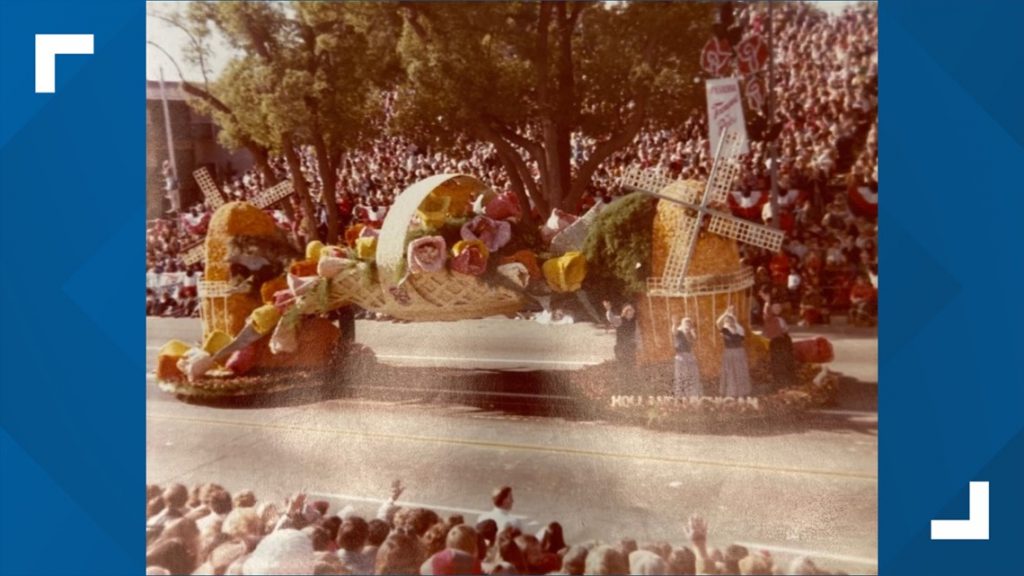
Photo Credit: WZZM TV
Over the following decades hotels have been built to accommodate the growing attendance. In 2001, due to the changes in climate, the festival was moved up by a week to coincide with the tulips’ blooming schedule.
2020’s Covid virus closed down the festival for that unprecedented situation, but it was back in full swing in 2021.
Mark Your Calendars!
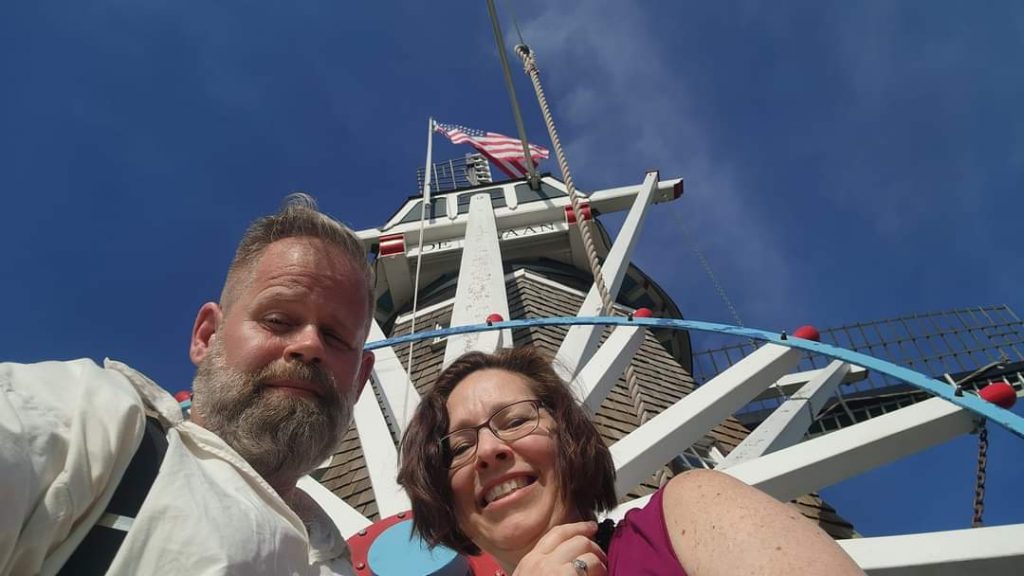
I have been impressed with the Holland community’s “Dutch Touch” and dedication to traditions!
I encourage you to mark your calendars for the eight day festival taking place in the beginning of May 2024! Next spring it will be the 95th year of the Tulip Time festival. which features 6 million blooming tulips throughout Holland. It’s an experience I recommend!
Resources:
Kinder Parade website
Take A Look Inside The DeZwaan Windmill
The Top 10 Things You Didn’t Know About Windmills
Tulip Time History

